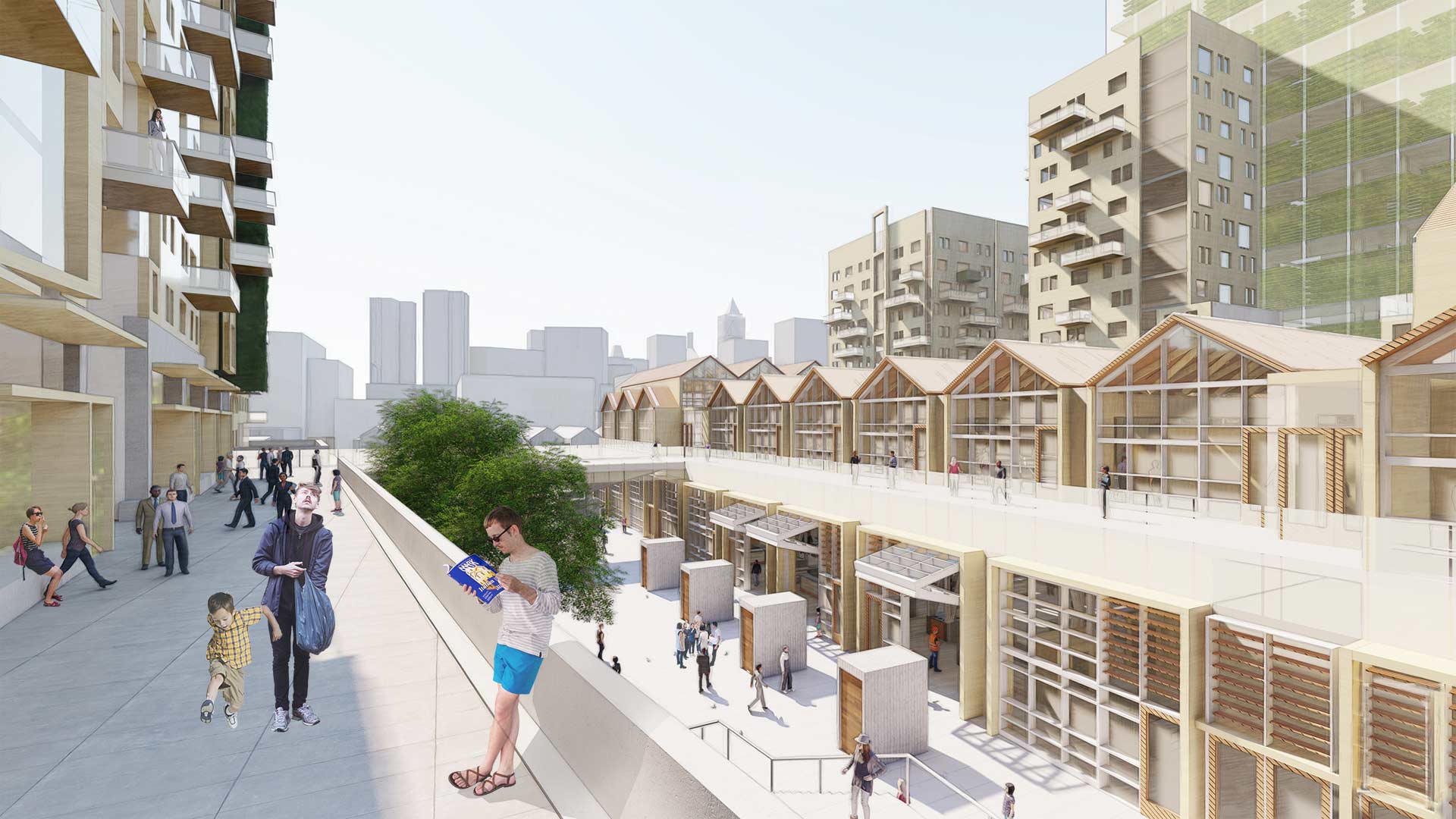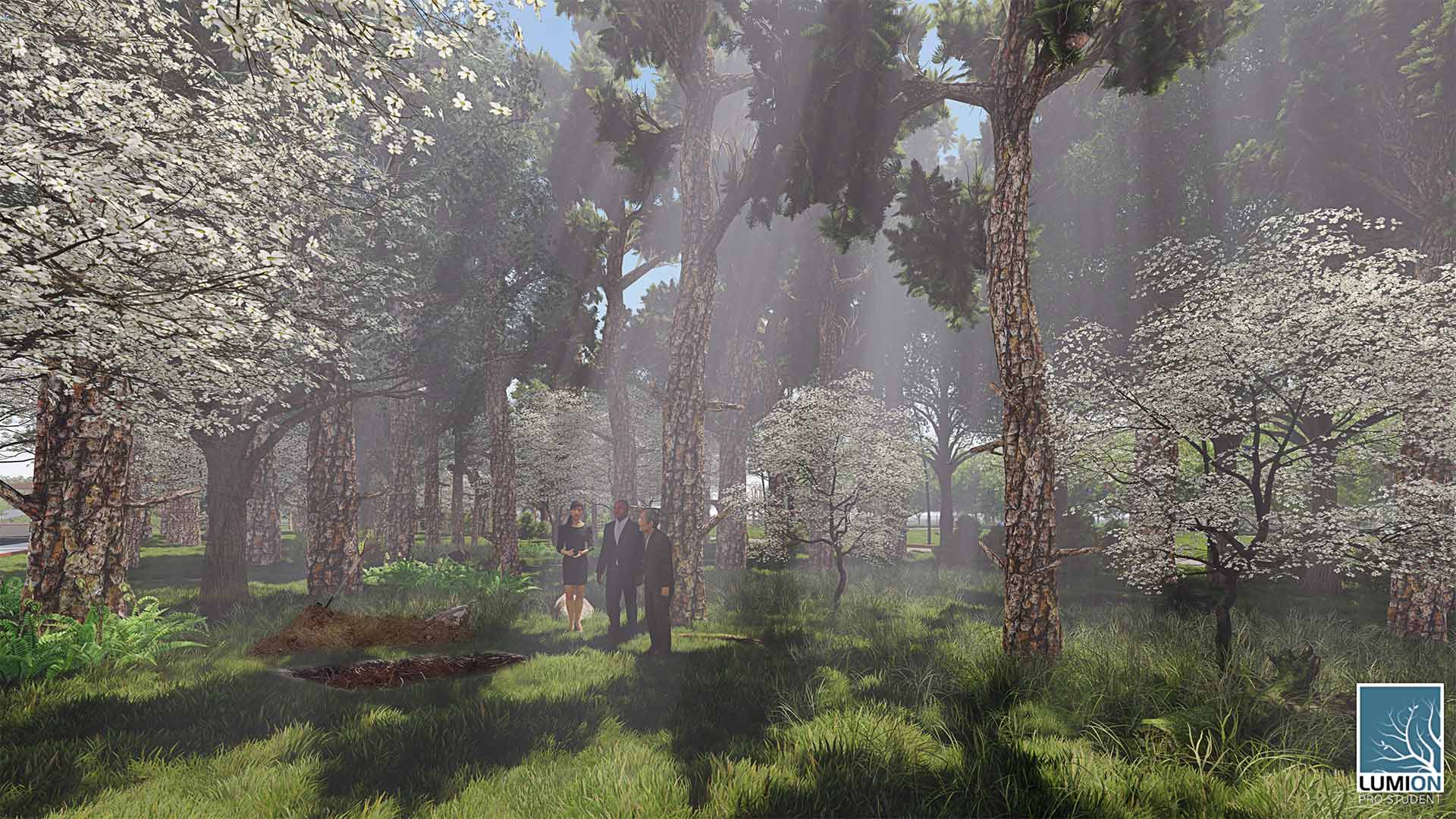- December 05, 2019
- By Maggie Haslam
Can architecture change the way we think about death?
A summer studying urban cemeteries in Scandinavia followed by two family funerals back home had architecture graduate student James Jesmer asking this question last year. The differences in how we approach and commemorate death in the U.S. was, in his mind, frustrating.
“Cemeteries in the U.S. today are these dedicated, gated spaces relegated to the suburbs,” he said. “They’ve become these forgotten places. I felt like there might be a better way.”
Next week, Jesmer will present his innovative idea to industry professionals and the campus community: an urban waterfront park and natural burial ground in the heart of Baltimore to celebrate life and its eventual end. He will join 19 other Master of Architecture candidates showcasing their final projects as part of the architecture program design thesis review, a mashup displaying skill, creativity and out-of-the-box thinking.
In the thesis, design is the common platform for tackling contemporary social, environmental and economic challenges. Student projects this time focus on multigenerational housing, the changing landscape of spirituality and the demise of the honeybee.
“Architecture is more than a beautiful building,” said Architecture Program Director Brian Kelly. “It strives to challenge the way we think about things and makes our environment perform at a higher level. The beauty of design thesis at Maryland is it allows our students to explore issues of personal interest from its design conception to a final solution, incorporating sustainability, social justice, beauty and buildability.”
Here’s a glimpse of some of the new projects:

Eric Bos
“Reviving the Heart of the City: Transforming Baltimore’s Oldest Market Into the City’s First Sustainable Food District”
Faculty Adviser: Brian Kelly
Bos took on the ironic task of revitalizing a public market in a current urban food desert. Lexington Market is where Baltimore purchased its food for centuries, but fresh produce is scarce in the neighborhood today, a commentary on the impact urbanization has on people’s access to food.
In Bos’ design, the exterior of the block is flanked by housing that offers light, air and views. The interior comprises the public market and a 10-story vertical farm, a climate-controlled agricultural incubator that uses the organic matter produced by the ground-floor vendors, restaurants and housing to create compost, heat and energy. The food grown is also sold, cooked or consumed on site, a process Bos hopes will renew the city’s connection with where its food comes from. “The idea is not about creating a hipster food hall, which is what more public markets are becoming,” said Bos. “It’s about reaching back to the space’s roots as an accessible public amenity that renews the existing community.”

Lauren Gilmartin
“Jakarta Underwater: Rising Seas as Opportunity”
Faculty Advisers: Ronit Eisenbach / Marccus Hendricks
Gilmartin’s project was inspired by a United Nations statistic: In 75 years, 5.5 billion people will live in coastal cities, primarily in Africa and Asia. “Compound that with the prediction of staggering rises in sea levels, (and) we are facing a big issue globally,” said Gillmartin, who is pursuing a dual degree in urban planning. The high levels of pollution in the Indonesian capital of Jakarta are creating an additional problem: The lack of clean water requires the city to pump groundwater, causing it to sink an average of 25 centimeters a year.
Through a 2019 David M. Schwarz fellowship, Gillmartin traveled to the Netherlands, Japan and Indonesia to research an affordable solution: a hydroelectrically powered building that takes advantage of changes in tidal levels to desalinate water and produce energy. Water collected can be distributed to residents, eliminating the need for groundwater pumping. “I was really committed to find a solution that not only works for the community but makes a better life for those who don’t often have a voice.”

Cassandra Huntington
“Social Enterprise Development: A Preventative Approach to Homelessness and Displacement in South Philadelphia”
Faculty Adviser: Julie Gabrielli
Thirty-seven percent of children who age out of foster care end up homeless within five years. It’s a statistic Huntington discussed often with her father, who works in drug and alcohol rehabilitation and sees young people struggling with chronic homelessness. “It’s a cycle that, once started, is more difficult to break,” she said. “But if you can intervene early, it’s more likely they can become self-sufficient and independent.”
Set in Philadelphia, Huntington’s project imagines a cluster of new and restored buildings that offer preventive measures to halt the cycle of homelessness, including a variety of housing types and a hub for continuing education, vocational training, and on-site mental and physical care. The housing is staged to ease individuals from transitional and rehab housing to more self-sufficient group living, then to mixed-income apartment housing. “Ideally, the model will get them in a situation where they can eventually be contributing members of the community.” Huntington capitalized on her dual degree in real estate development to ensure her plan is not just sustainable, but also self-funding. Revenue from the site’s market rate housing and retail space will cycle back to support programming.

James Jesmer
“Death in the Round: A Critique of Funeral Architecture and Burial Practices”
Faculty Adviser: Lindsay May
Jesmer’s design tackles issues surrounding death, including cemetery overcrowding and the massive resources required for burial, including non-sustainable materials and carbon-producing cremation. Just as important to Jesmer was breaking down the stigma associated with death. To do this, he proposes bringing the cemetery back to the city, specifically Port Covington, Baltimore, where green space on the waterfront will serve as both a burial site and a serene passage to a park. “I think there will be people very excited about this, but also people thinking, ‘You can’t bury people where I’m going to play Frisbee.’ But the idea is, the more it can be integrated, the better it can be received.” Graves are marked digitally and can be located with GPS. A cluster of nearby intimate spaces serve as a nondenominational ceremony hall for services, the mortuary, reception and courtyards. A public entrance filters into more private corridors that move into the burial landscape for remembrance and reflection.
Topics
Campus & CommunityTags
Architecture